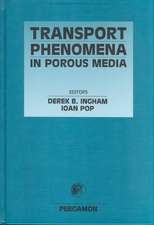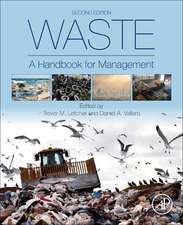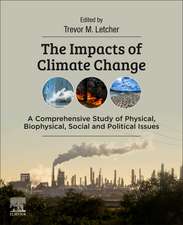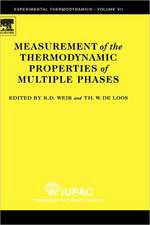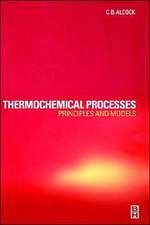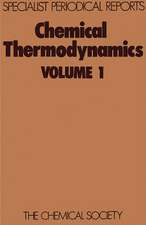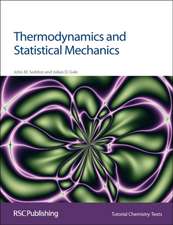Heat Capacities: Liquids, Solutions and Vapours
Editat de Emmerich Wilhelm, Trevor M Letcheren Limba Engleză Hardback – 31 iul 2010
Preț: 943.46 lei
Preț vechi: 1097.04 lei
-14% Nou
Puncte Express: 1415
Preț estimativ în valută:
180.52€ • 188.50$ • 149.07£
180.52€ • 188.50$ • 149.07£
Carte tipărită la comandă
Livrare economică 15-29 aprilie
Preluare comenzi: 021 569.72.76
Specificații
ISBN-13: 9780854041763
ISBN-10: 0854041761
Pagini: 516
Dimensiuni: 157 x 236 x 38 mm
Greutate: 0.9 kg
Ediția:Edition.
Editura: Royal Society Of Chemistry
Locul publicării:Cambridge, United States
ISBN-10: 0854041761
Pagini: 516
Dimensiuni: 157 x 236 x 38 mm
Greutate: 0.9 kg
Ediția:Edition.
Editura: Royal Society Of Chemistry
Locul publicării:Cambridge, United States
Public țintă
ResearchDescriere
The book contains the very latest information on all aspects of heat capacities related to liquids and vapours, either pure or mixed. The chapters, all written by knowledgeable experts in their respective fields, cover theory, experimental methods, and techniques (including speed of sound, photothermal techniques, brillouin scattering, scanning transitiometry, high resolution adiabatic scanning calorimetry), results on solutions, liquids, vapours, mixtures, electrolytes, critical regions, proteins, liquid crystals, polymers, reactions, effects of high pressure and phase changes. Experimental methods for the determination of heat capacities as well as theoretical aspects, including data correlation and prediction, are dealt with in detail. Of special importance are the contributions concerning heat capacities of dilute solutions, ultrasonics and hypersonics, critical behavior and the influence of high pressure.
Cuprins
Chapter 1: Heat Capacities: Introduction, Concepts and Selected Applications; Chapter 2: Calorimetric Methods for Measuring Heat Capacities of Liquids and Liquid Solutions; Chapter 3: An Exact Analysis of Conductive Heat Losses in a Flow Calorimeter for Heat capacity Measurement; Chapter 4: Excess Heat Capacities and Related Properties of Liquid mixtures; Chapter 5: Heat Capacity of Non-Electrolyte Solutions; Chapter 6: Heat Capacities and Related Properties of Vapours and Vapour Mixtures; Chapter 7: Heat Capacity of Electrolyte Solutions; Chapter 8: Scanning Transitiometry and its Use to Determine Heat Capacities of Liquids at High Pressures; Chapter 9: Chapter 9 Sound Speed Measurements and Heat Capacities of gases; Chapter 10: Speed of Sound Measurements and Heat Capacities of Liquid Systems at High Pressure; Chapter 11: Heat Capacities and Brillouin Scattering in Liquids; Chapter 12: Photothermal Techniques for Heat Capacities; Chapter 13: High Resolution Adiabatic Scanning Calorimetry and Heat Capacities; Chapter 14: Heat Capacities in the Critical Region; Chapter 15: Heat Capacity of Polymeric Systems; Chapter 16: Protein Heat Capacity; Chapter 17: Specific Heat in Liquid Crystals; Chapter 18: Heat Capacities and Phase Transitions for the Dynamic Chemical Systems: Conformers, Tautomers, Plastic Crystals and Ionic Liquids; Chapter 19: The Estimation of Heat Capacities of Pure Liquids; Chapter 20: Computer Simulation Studies of Heat Capacity Effects Associated with Hydrophobic Effects; Chapter 21: Partial Molar Heat Capacities of Gases Dissolved in Liquid; Chapter 22: Heat Capacities of Molten Salts
Notă biografică
Professor Emmerich Wilhelm is Vice-Head and Head of the Institute of Physical Chemistry atthe University of Wien, Vienna, Austria. Prior to that, he was Visiting Professor at Wright State University, Dayton, Ohio, USA, the Université Blaise Pascal, Clermont-Ferrand, France and the University of Salzburg, Salzburg, Austria. For many years, Professor Wilhelm was a member of the Editorial Boards of Solubility Data Series (IUPAC), Fluid Phase Equilibria, Materials Chemistry and Physics, International DATA Series A, Thermochimica Acta and an Associate Member, and/or National Representative, and/or Member of the IUPAC Commission I.2: Thermodynamics and the IUPAC Commission V.8: Solubility Data (Gas Solubilities). He wasalso a Member of the Board of Directors of the European Society of Applied Physical Chemistry,US Calorimetry Conference and the International Council on Materials Education. ProfessorWilhelm has published over 160 papers in peer reviewed journals in the areas ofthermodynamics, physical chemistry of solutions, was Co-Organizer of 20 international scientific conferences and has given more than 110 Plenary/ Keynote/ Invited Lectures. He has been the recipient of the Felix-Kuschenitz Award (Thermophysics), Austrian Academy of Science, the Huffman Award, Calorimetry Conference, USA and the Doctor Honoris Causa, Université Blaise Pascal, Clermont-Ferrand, France.
Caracteristici
Covers a wide range of topics
Key point of reference for anyone working in the field or related areas
Key point of reference for anyone working in the field or related areas
Textul de pe ultima copertă
The book contains the very latest information on all aspects of heat capacities related to liquids and vapours, either pure or mixed. The chapters, all written by knowledgeable experts in their respective fields, cover theory, experimental methods, and techniques (including speed of sound, photothermal techniques, brillouin scattering, scanning transitiometry, high resolution adiabatic scanning calorimetry), results on solutions, liquids, vapours, mixtures, electrolytes, critical regions, proteins, liquid crystals, polymers, reactions, effects of high pressure and phase changes. Experimental methods for the determination of heat capacities as well as theoretical aspects, including data correlation and prediction, are dealt with in detail. Of special importance are the contributions concerning heat capacities of dilute solutions, ultrasonics and hypersonics, critical behaviour and the influence of high pressure. This new book covers the wide range of topics in the field of heat capacities and vapours and as such is a key point of reference for undergraduates and graduates alike as well as researchers, academics and anyone working in the field or related areas.

